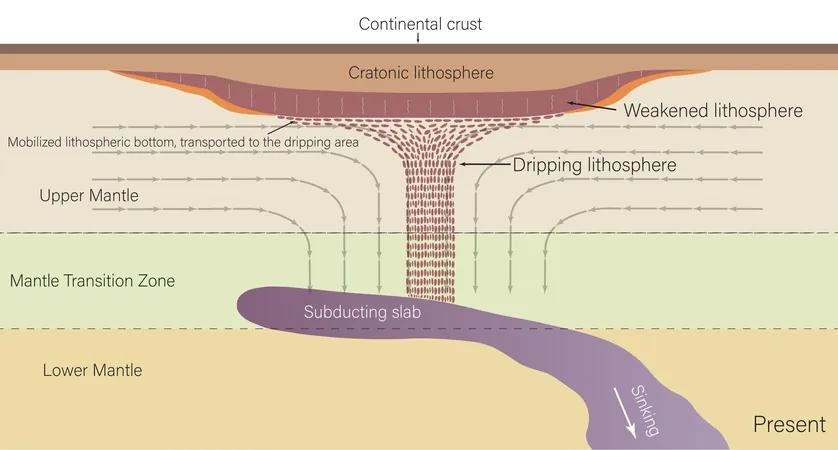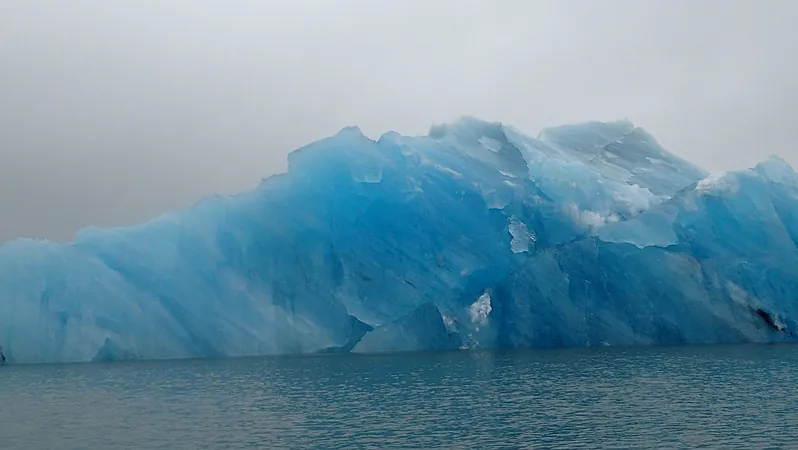
Shocking Discovery: North America’s Crust is Literally Dripping!
2025-04-01
Author: Benjamin
Groundbreaking Revelation
In a groundbreaking revelation that could reshape our understanding of geological processes, researchers have confirmed that the underside of the North American continent is currently "dripping" away in blobs of rock. This striking phenomenon, detailed in a recent paper published in Nature Geoscience, suggests that remnants of a tectonic plate sinking into the Earth's mantle may be responsible for this unexpected activity.
Seismic Research Unravels the Mystery
A team of scientists from The University of Texas at Austin, led by postdoctoral fellow Junlin Hua, unraveled this mystery through innovative seismic research. "We observed that there could be something beneath the craton," Hua remarked, alluding to the ancient geological formations known as cratons, which are typically stable and endure for billions of years. However, they can experience significant changes that affect their overall stability.
Focus on the Midwest Region
The current focus of this phenomenon is primarily over the Midwest region of the United States, although researchers emphasize that there is no immediate cause for concern regarding the structural integrity of the continent. The processes driving this dripping are gradual, ensuring that significant alterations to the landscape are far off. Eventually, as the tectonic remnants continue to sink deeper into the mantle, their influence will wane, and the dripping is expected to cease.
Implications for Geoscience
This discovery is particularly essential for geoscientists examining the long-term evolution of continental structures. Co-author Thorsten Becker highlighted the broader implications of their findings, stating, "Understanding how a planet evolves over time is crucial. It helps us grasp the processes involved in forming continents, breaking them apart, and recycling materials back into the Earth."
Innovative Seismic Model Development
The research stems from a creative project aimed at developing a new full-waveform seismic tomographic model of North America. Utilizing seismic data gathered by the EarthScope project, the model unveiled new insights into the intricate geological mechanisms at play beneath the continent. Importantly, it identified the Farallon Plate—an oceanic tectonic plate that has been subducting under North America for approximately 200 million years—as a possible catalyst for this dripping phenomenon, despite being over 600 kilometers away from the craton itself.
Interactions and Simulations
As the Farallon Plate interacts with material across a vast area of the craton, researchers have discovered that a diverse range of regions are experiencing this thinning effect. Simulations demonstrated that the dripping occurs only when the Farallon Plate is accounted for in the model, reinforcing its critical role in the process.
Optimism about Computer Models
While computer models come with their limitations, Becker remains optimistic about their accuracy. "We are continually evaluating whether these models reveal new truths about Earth," he commented, noting that the patterns observed in the data lend credence to the phenomenon of cratonic dripping.
Future Implications and Curiosity
Stay tuned as this fascinating research unfolds! What other secrets might our planet's surface hold? The implications of this study could change our understanding of geology and Earth's dynamic processes for years to come!









 Brasil (PT)
Brasil (PT)
 Canada (EN)
Canada (EN)
 Chile (ES)
Chile (ES)
 Česko (CS)
Česko (CS)
 대한민국 (KO)
대한민국 (KO)
 España (ES)
España (ES)
 France (FR)
France (FR)
 Hong Kong (EN)
Hong Kong (EN)
 Italia (IT)
Italia (IT)
 日本 (JA)
日本 (JA)
 Magyarország (HU)
Magyarország (HU)
 Norge (NO)
Norge (NO)
 Polska (PL)
Polska (PL)
 Schweiz (DE)
Schweiz (DE)
 Singapore (EN)
Singapore (EN)
 Sverige (SV)
Sverige (SV)
 Suomi (FI)
Suomi (FI)
 Türkiye (TR)
Türkiye (TR)
 الإمارات العربية المتحدة (AR)
الإمارات العربية المتحدة (AR)